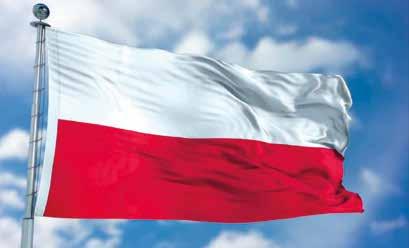Special
Poland
WHERE WOOD IS A STRATEGIC AND NATURAL RESOURCE FORMER EASTERN BLOCK LAND IS ALSO CONSIDERING A BAN ON WOOD EXPORTS OUTSIDE THE EU A few years ago, the Polish wood timber harvest was 40 to 42 million cubic metres of wood a year, mainly from state-owned forests (96%). Coniferous wood dominates timber harvesting (75%), whilst 88% of rough wood material is meant for industrial processing, 53% of which is pulpwood and 47% sawing and veneer trunks. If we go back to 2015, for instance, we note how over 6% of the harvested wood was exported, whilst wood imports came to about 6% in proportion to the harvesting.
Wood sector The wood processing industry certainly forms up a major portion of the Polish economy, with a share of 2% in the GDP, 3.3% of the total production of Poland, and 2.2% of the gross added value (2015-16). The sector represents over 62,000 business units, mainly small and very small timber companies (92%, mainly saw mills and furniture companies).
If there is a country in the European Union where wood plays a major part, it has to be Poland. Wood is a strategic and natural resource in this former Eastern Block land and you can regard the forestry-wood sector as a flagship of the economy. Poland has considerable forestry and raw material reserves on both a European and a global scale. The country has a particularly large forest acreage (seventh place in the European Union), a wealthy base of raw materials (fourth place), and a relatively large volume of wood production (fifth place). These factors make Poland one of the most important producers on both the European and global markets. It’s also important to mention that the country enjoys considerable prestige in Europe because it is striving for sustainable use and rational management of its resources.
Furniture production and fibre boards If we consider matters from an industrial perspective, we note that Poland occupies sixth place worldwide and third place in Europe in furniture production. Exports from that same furniture sector represent no less than 6% of the total on the world market. Moreover, the country is also a major producer of wooden boards (seventh biggest producer in the world and the second in Europe). Within Europe Poland is mainly a major exporter of fibre board, especially porous board with a wet production process (first place). The country itself has expanded both its forest acreage (9.2 million hectares) and its resources (2.5 billion cubic metres) in recent years. Forests cover over 30% of the country and the proportion of hectares of forest per head of population is currently 0.24. Polish forests are the main source of wood for the national wood industry and the wood supply does not really depend on foreign trade.
32
Floor Forum International 121
The extremely diverse Polish wood sector generates 9% of the value of commercial production and creates 12% of jobs in industry as a whole. The furniture industry also constitutes the flagship, with 35% of commercial production, 49% of employment, and a representation of 41% of the business units. In fact, the furniture industry has earned the status of ‘national industrial specialisation’ and stands out amidst the national industries which have already become prominent or could become prominent on the global market in the future. As regards its development, the wood sector, like the Polish economy, rests largely on industries like pulp and paper, paper processing, wood panels, and joinery and woodwork for buildings. The wood sector has been one of the few sectors in Poland to achieve a positive trade balance in recent years, and that has invariably reduced the Polish deficit in foreign trade. For instance, five years ago, the sector’s share in national exports was 9% and in imports 4%, whilst about 70% of wood was exported in the form of products with a high added value. Poland’s foreign trade in wood and wood products has targeted the European market, which has received 83% of Polish wood and Polish wood products, whilst at the same time almost 82% of the wood and wood products imported into Poland has come from the European Union. It is absolutely clear how important the forestry and wood sector is in Poland as a stimulus for local development and enterprise, especially in less developed regions.
Parquet sector How does the parquet sector relate to all this? We haven’t found very much recent data, but based on general European trends in recent years we can reasonably assume that the parquet market in Poland (where oak plays a major part) is continuing to grow, as it is in other European countries. For instance, figures from 2017 show that 65,603,120m² of parquet were produced in Europe in that










